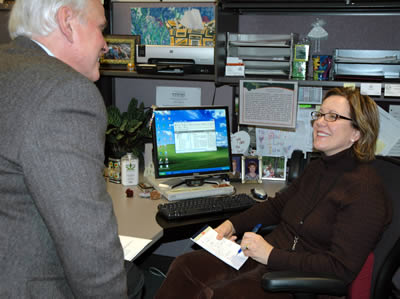By Deb Ledvina, Mn/DOT ombudsman

Jim Pence and Deb Ledvina research and try to resolve complaints from contractors,homeowners, businesses or communities affected by Mn/DOT construction projects. Photo by Craig Wilkins |
A large bureaucracy like Mn/DOT has to have rules and policies that are intended to fit every situation. Occasionally, however, that “one size fits all” approach forces a few unusual exceptions through the cracks, in spite of the best efforts of Mn/DOT employees.
That’s the 1 percent that comes to the new Ombudsman’s Office—my office—for review. It’s a role I’ve held since last fall when Commissioner Tom Sorel asked me to serve as Mn/DOT’s first ombudsman.
Although I am trained as a lawyer, and have worked for Mn/DOT as an attorney for 16 years, I have not felt comfortable in the traditional adversarial role that many lawyers assume. I’ve always been a problem solver; I believe that there are common interests in each situation which can lead to a satisfactory outcome.
I love people, listening to stories, asking questions and learning how and why certain decisions are made.
That’s a big part of my new job, which officially is to resolve issues that can’t be resolved through standard procedures or have been resolved, but not to the satisfaction of the agencies or people involved.
My work focuses mainly on issues related to the project delivery process for construction projects, such as resolving issues with contractors, homeowners, businesses or communities affected by Mn/DOT construction projects.
Whether it’s a home that was badly shaken by vibrations from our compacters or a business owner’s sign that has been in our right of way for 20 years and needs to be removed, the questions coming to my office all have one thing common: a Mn/DOT stakeholder who feels he or she is being treated unfairly.
After the facts are known about a situation, the commissioner and I meet, discuss suggested remedies (if needed), and make a decision to resolve the issue or conflict. The commissioner is the sole decision-maker; his decision is final.
Most often I find that people may only need to be heard or shown some empathy for their concerns. Often, explaining a process in easy to understand language is enough. Sometimes we need to do more because a decision made or policy applied had unintended results which need to be resolved.
I try to add value to the issues by bringing a different perspective to the table. I always ask, “How can we make this better from our customers’ perspective?”
I recognize we have constraints in how we operate, but sometimes just saying “I’m sorry for the inconvenience we have caused you” carries a lot of meaning.
My role is part-mediator, part-educator and part-communicator for Mn/DOT. My staff (Jim Pence and Lydia Montgomery) and I are dedicated to working with the public and our external stakeholders to resolve any issues they have with our agency. By doing this, we hope to build public trust and confidence in Mn/DOT and demonstrate our commitment to the people we serve and to the partners with whom we work.
While there isn’t an easy remedy for every situation or issue, most can be handled to respect each participant’s value and legitimacy and create a better understanding, if not agreement, of the issue. That’s our goal.
For more information about the role of the department’s ombudsman, see http://www.dot.state.mn.us/ombudsman/.
Prior to becoming Mn/DOT’s ombudsman, Deb Ledvina worked in a variety of areas within the department, including the offices of Administration, Transportation Data Analysis, Investment Management, and Freight and Commercial Vehicle Operations. Ledvina also was the director of a legal services agency and practiced law for a variety of non-profit organizations before joining Mn/DOT.
|



